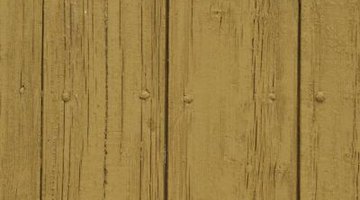Paint Won't Stick to Wood Paneling
Painting over wood paneling can update a tired room, but the process isn't as simple as just painting the walls. If the surface of the wood is not properly prepared, the paint won’t stick. Sanding, cleaning and priming are critical steps in painting wood paneling successfully. Skipping these steps is typically the cause of peeling paint later, and doubles your work in the end because to repair you’ll have to sand and repaint.
Sanding

Most paneling is coated with a glossy finish to protect the wood. Although older paneling may appear to have lost its finish, there is often still a thin coat remaining. Paint and primer will not adhere to this coating, so to prevent problems later, sand all paneling prior to painting. Use fine grit sandpaper to avoid gouging the wood, and sand the entire wall, making sure you remove all traces of the sheen. Rinse away the dust and debris with a damp towel.
Cleaning
Paneling must be cleaned prior to painting. Even if you’ve primed, an unclean surface will not allow the paint to adhere. Older paneling in particular may appear to have lost its glossy finish, but it still has layers of dust, grease and other material which paint won’t stick to. Wash the entire wall using soapy water and rinse well. For paneling in areas such as kitchens, where grease may build up, use a trisodium phosphate cleaner.
Priming
A coating of primer not only helps to avoid multiple coats of paint, but it gives your top coats an ideal surface to adhere to. The right primer is also critical to the job. Ideally, an oil primer is best for paneling because it provides stain-blocking and will adhere to most surfaces. However, without adequate ventilation, these primers can be strong-smelling. Water-based or latex primers will also work, but use a urethane-modified acrylic or those labeled as stain-blocking for best results. The paneling must be thoroughly cleaned when using latex primers. Follow the primer coat with at least two coats of quality paint.
Gaps, Holes and Cracks
Gaps where the sheets of paneling meet, holes, cracks, and other imperfections are often revealed after priming. These should not be ignored or the paint may begin to peel away in these areas. Before painting, caulk imperfections and fill holes. Sand the caulk smooth and leave it to dry completely before applying paint.
References
Writer Bio
Renee Miller began writing professionally in 2008, contributing to websites and the "Community Press" newspaper. She is co-founder of On Fiction Writing, a website for writers. Miller holds a diploma in social services from Clarke College in Belleville, Ontario.
Photo Credits
- Hemera Technologies/AbleStock.com/Getty Images
More Articles



